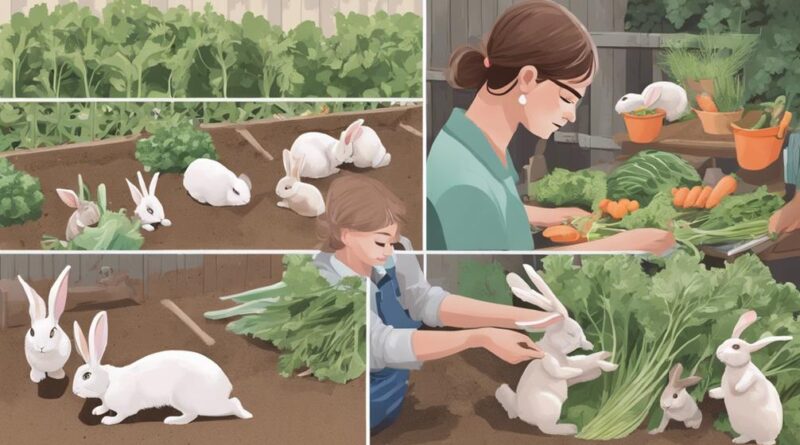Three Top Tips for Rabbit Rescue Volunteers Training
Master handling techniques, understand behaviors, and prioritize health protocols for rabbit rescue volunteer training. Ensure well-being and care for these furry friends by learning how to handle rabbits properly, interpreting their cues, and following health guidelines. Additionally, pay attention to their nutrition, create enrichment activities, and collaborate effectively within your team. Your dedication and knowledge will make a significant impact on the lives of rescued rabbits. More insights await on ways to build trust, handle emergencies, and enhance team communication for a fulfilling volunteer experience in rabbit rescue.
Importance of Proper Handling Techniques
Why is mastering proper handling techniques crucial for every rabbit rescue volunteer?
Proper restraint and gentle handling are essential skills that directly impact the well-being and safety of the rabbits under your care. When you handle a rabbit correctly, you not only ensure their physical comfort but also build trust and create a positive experience for both you and the rabbit.
Proper restraint is key to preventing injuries to the rabbit and yourself. When lifting a rabbit, always support their hindquarters to avoid putting pressure on their fragile spine. This technique helps prevent unnecessary stress or harm to the rabbit. Additionally, using gentle handling techniques minimizes the risk of the rabbit feeling scared or threatened, which can lead to defensive behaviors like scratching or biting.
Understanding Rabbit Behavior
To understand rabbit behavior effectively, observe their body language and vocalizations closely. Rabbits communicate a lot through their body movements. Understanding body language is crucial in deciphering how they're feeling. For example, when a rabbit thumps its hind legs, it might be expressing fear or agitation. Ears positioned forward indicate curiosity or contentment, while ears laid flat against the back signal fear or anger. By paying attention to these cues, you can better respond to their needs and emotions.
Rabbits are social animals that have a complex social hierarchy. They establish dominance through behaviors like chin rubbing, nudging, or circling. It's important to recognize these interactions, especially when introducing new rabbits to each other or to other pets in the household. Understanding their social behavior can help prevent conflicts and ensure a harmonious living environment for the rabbits.
When it comes to vocalizations, rabbits are generally quiet animals. However, they can make soft purring sounds when they're happy and comfortable. Loud teeth grinding or high-pitched squealing can indicate pain or distress. By being attuned to these vocal cues, you can promptly address any potential issues and provide the necessary care and attention. Paying close attention to body language and vocalizations is key to building a strong bond with the rabbits in your care.
Health and Safety Protocols
Ensuring the health and safety of rescued rabbits requires strict adherence to established protocols and guidelines. As a rabbit rescue volunteer, it's crucial to familiarize yourself with the training procedures and emergency response protocols to effectively care for these vulnerable animals.
Training procedures are designed to equip you with the necessary skills and knowledge to handle various health and safety aspects of rabbit rescue. This includes learning how to properly assess a rabbit's health, recognize common signs of illness or distress, and administer basic first aid when needed. By following these procedures diligently, you can ensure that the rabbits under your care receive the best possible attention and support.
In the event of an emergency, quick and decisive action can make a significant difference in the outcome for a rescued rabbit. Understanding the emergency response protocols is essential to effectively manage crisis situations, such as injuries, sudden illnesses, or escape attempts. Knowing who to contact, where to find emergency supplies, and how to provide immediate assistance can help minimize risks and ensure the safety of the rabbits in your care.
Providing Proper Nutrition
As you continue your role as a rabbit rescue volunteer, understanding the nutritional needs of rescued rabbits is vital for their overall well-being and recovery. Providing proper nutrition is crucial to help them regain their health and strength. When it comes to dietary requirements, rabbits need a diet rich in hay, fresh vegetables, and a limited amount of pellets.
Hay should make up the majority of their diet as it aids in digestion and keeps their teeth healthy. Fresh vegetables like dark leafy greens, carrots, and bell peppers provide essential vitamins and minerals. Pellets should be given in moderation to prevent obesity and other health issues.
Establishing consistent feeding schedules is also essential for the well-being of rescued rabbits. They thrive on routine, so try to feed them at the same times each day. This helps regulate their digestive system and keeps them comfortable and content. Additionally, make sure to provide fresh, clean water at all times to keep them hydrated and healthy.
Creating Enrichment Activities
Consider incorporating interactive toys and games to engage rescued rabbits mentally and physically, promoting their overall well-being and happiness. Enrichment challenges are essential for rabbits as they help prevent boredom and encourage natural behaviors. Interactive toys, such as puzzle feeders or treat balls, provide mental stimulation while also offering a reward for the rabbit's efforts.
Introducing different types of interactive toys can keep the rabbits engaged and curious. For example, rotating toys on a schedule can prevent them from losing interest. Hide treats inside toys or create obstacle courses using tunnels and ramps to challenge their problem-solving skills and agility.
Furthermore, rabbits enjoy digging and foraging, so providing materials like hay piles, cardboard boxes filled with shredded paper, or digging boxes with safe substrates can mimic their natural behaviors. These activities not only keep them physically active but also mentally stimulated.
When designing enrichment activities, consider the individual preferences of each rabbit. Some may prefer toys that involve tossing or chewing, while others may enjoy activities that encourage exploration. Observation is key to understanding what each rabbit enjoys and tailoring enrichment to suit their needs. By incorporating a variety of interactive toys and challenges, you can help rescued rabbits lead happier and healthier lives.
Handling Medical Emergencies
To effectively handle medical emergencies involving rescued rabbits, it's crucial to be prepared with the necessary knowledge and resources. In the world of rabbit rescue, being equipped to respond to emergencies promptly can save lives. Familiarize yourself with common medical issues in rabbits such as GI stasis, heat stroke, or injuries. This knowledge will help you identify symptoms early on and take swift action.
In an emergency response situation, staying calm is key. Assess the rabbit's condition carefully but swiftly. If the rabbit is unresponsive, having a basic understanding of first aid techniques can make a significant difference. For instance, knowing how to perform CPR on a rabbit or stabilize a fracture can be life-saving skills. Always have an emergency kit handy with essentials like sterile gauze, bandages, and contact information for a rabbit-savvy vet.
Building Trust With Rescued Rabbits

To create a strong bond and establish trust with rescued rabbits, patience and understanding are essential. Gaining confidence from these delicate animals takes time and care. When working with rescued rabbits, remember that they may have experienced trauma or neglect, causing them to be wary of humans. Building relationships with them requires a gentle approach.
Start by giving them space to acclimate to their new surroundings. Offer them treats and speak to them softly to show that you're a friend, not a threat.
Spending time sitting near their enclosure can help them get used to your presence. Avoid sudden movements or loud noises that might startle them. Slowly introduce gentle petting, always observing their body language for signs of discomfort. Each rabbit is unique, so take the time to learn their individual preferences and boundaries. Consistency is key in gaining their trust.
Effective Communication With Team
For effective communication within your team, prioritize open and honest dialogue to foster collaboration and understanding. Team collaboration is essential for the success of any rescue mission. Communication strategies play a crucial role in ensuring that everyone is on the same page and working towards a common goal.
To enhance team collaboration, establish regular team meetings where everyone can discuss progress, challenges, and ideas. Encourage all team members to actively participate by sharing their thoughts and suggestions. This open exchange of information can lead to innovative solutions and a stronger sense of unity within the team.
Utilize various communication channels to keep everyone informed and engaged. Whether it's through emails, messaging apps, or in-person meetings, make sure that important information is effectively communicated to all team members. This ensures that everyone is well-informed and can contribute meaningfully to the rescue efforts.
In addition to verbal communication, non-verbal cues also play a significant role in team dynamics. Pay attention to body language and other subtle signals to gauge the team's morale and address any underlying issues promptly. By fostering an environment of open communication and mutual respect, you can create a cohesive team that works together harmoniously towards the welfare of the rescued rabbits.
Frequently Asked Questions
How Can I Help a Shy Rabbit Come Out of Its Shell?
To help a shy rabbit come out of its shell, start by building trust. Spend quiet time near the rabbit, talking softly and offering treats.
Encourage socialization by creating a safe space for the rabbit to explore. Gradually introduce new experiences and interactions, always respecting the rabbit's boundaries.
With patience and positive reinforcement, the rabbit will begin to feel more comfortable and confident, slowly coming out of its shell.
What Do I Do if a Rabbit Stops Eating Suddenly?
If a rabbit stops eating suddenly, it may indicate a serious issue. Start by checking for any health concerns and seek veterinary help if needed.
Offer tempting foods like leafy greens to encourage eating. Ensure proper nutrition tips are followed to support your rabbit's health.
Handling stress is crucial during this time, so create a calm environment. Remember, quick action and proper care can help your rabbit get back on track.
Is It Normal for Rabbits to Thump Their Feet?
It's normal for rabbits to thump their feet as a way of signaling their emotions. Understanding rabbit behavior is key here. Thumping signals can indicate fear, stress, or even displeasure.
Pay close attention to this body language cue when communicating with rabbits. By acknowledging their signals, you can better understand how they're feeling and provide the care and support they need.
How Do I Introduce Two Rabbits to Each Other?
When introducing two rabbits to each other, start by letting them interact in a neutral space to prevent territorial issues. Use bonding techniques like scent swapping and supervised play sessions to help them get comfortable with each other.
Watch for positive behavior cues such as grooming and shared resting spots. Gradually increase their time together to encourage socialization.
What Should I Do if a Rabbit Escapes During Playtime?
If a rabbit escapes during playtime, prevention is key. Always supervise play and secure the area beforehand. Should an escape happen, stay calm and act quickly.
Use familiar sounds or treats to lure the rabbit back. Avoid chasing to prevent further stress. Ensure the rabbit is safe and check for any injuries.
Review your playtime strategies and consider rabbit enrichment to prevent future escapes.
Conclusion
In conclusion, remember that as a rabbit rescue volunteer, your role is vital in providing proper care and support for these vulnerable animals.
By following these top tips for training, you can ensure the well-being and happiness of the rabbits in your care.
Your dedication and compassion make a difference in their lives, so continue to educate yourself, build trust, and communicate effectively with your team to create a safe and loving environment for these precious animals.
